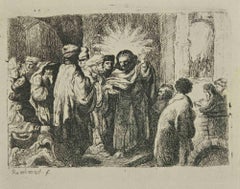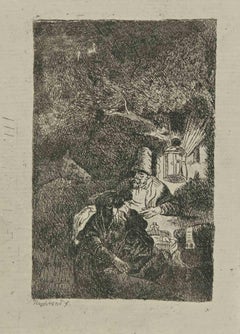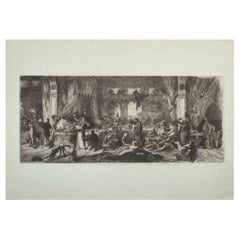Want more images or videos?
Request additional images or videos from the seller
1 of 7
Rembrandt van RijnThe Death of the Virgin - Original Etching by Rembrandt - 16391639
1639
About the Item
- Creator:Rembrandt van Rijn (1606 - 1669, Dutch)
- Creation Year:1639
- Dimensions:Height: 15.56 in (39.5 cm)Width: 12.41 in (31.5 cm)Depth: 0.04 in (1 mm)
- Medium:
- Movement & Style:
- Period:1630-1639
- Condition:Insurance may be requested by customers as additional service, contact us for more information.
- Gallery Location:Roma, IT
- Reference Number:Seller: J-455871stDibs: LU65034382502
Rembrandt van Rijn
Rembrandt was the most influential 17th Century Dutch painter. After years of early success as a portrait painter, his life was beset by financial hardship and personal tragedy. He continued to paint portraits and develop etchings. Rembrandt's portraits of his contemporaries, self-portraits and illustrations of scenes from the Bible are regarded as his greatest creative triumphs. His self-portraits form a unique and intimate autobiography, in which the artist surveyed himself without vanity and with the utmost sincerity. Like many artists of the Dutch Golden Age, such as Jan Vermeer of Delft, Rembrandt was also an avid art collector and dealer. Rembrandt never went abroad, but he was considerably influenced by the work of the Italian masters and Netherlandish artists who had studied in Italy, like Pieter Lastman, the Utrecht Caravaggists, Flemish Baroque, and Peter Paul Rubens. Rembrandt's foremost contribution in the history of printmaking was his transformation of the etching process from a relatively new reproductive technique into a true art form, along with Jacques Callot. His reputation as the greatest etcher in the history of the medium was established in his lifetime and never questioned since. Few of his paintings left the Dutch Republic while he lived, but his prints were circulated throughout Europe, and his wider reputation was initially based on them alone.
About the Seller
4.9
Platinum Seller
Premium sellers with a 4.7+ rating and 24-hour response times
1stDibs seller since 2017
7,760 sales on 1stDibs
Typical response time: 2 hours
Authenticity Guarantee
In the unlikely event there’s an issue with an item’s authenticity, contact us within 1 year for a full refund. DetailsMoney-Back Guarantee
If your item is not as described, is damaged in transit, or does not arrive, contact us within 7 days for a full refund. Details24-Hour Cancellation
You have a 24-hour grace period in which to reconsider your purchase, with no questions asked.Vetted Professional Sellers
Our world-class sellers must adhere to strict standards for service and quality, maintaining the integrity of our listings.Price-Match Guarantee
If you find that a seller listed the same item for a lower price elsewhere, we’ll match it.Trusted Global Delivery
Our best-in-class carrier network provides specialized shipping options worldwide, including custom delivery.You May Also Like
Church of St. Costanza, Rome: An 18th Century Piranesi Architectural Etching
By Giovanni Battista Piranesi
Located in Alamo, CA
This is a framed 18th century Giovanni Battista Piranesi etching entitled: "Veduta interna del Sepocro di Santa Costanza, fabbricat...
Category
1770s Old Masters Interior Prints
Materials
Etching
$3,775
H 27 in W 32 in D 1.5 in
William Hogarth's "Analysis of Beauty": A Set of Two Framed 18th C. Engravings
By William Hogarth
Located in Alamo, CA
The two plates in this set were created utilizing both engraving and etching techniques by William Hogarth in 1753, originally as illustrations of his book on aesthetics, entitled "Analysis of Beauty". Due to their popularity, these plates were later published separately. The publication line in the lower right reads: "Designed, Engraved, and Publish'd by Wm. Hogarth, March 5th 1753, according to Act of Parliament." Hogarth's original copper plates were refurbished where needed by James Heath and engravings were republished in London in 1822 by Braddock, Cradock & Joy. This was the last time Hogarth's copper plates were used for printing. Most were melted during World War I for the construction of bombs.
These large folio sized "Analysis of Beauty" engravings are presented in antiqued gold-colored frames with double mats; the outer silk mats are light brown-colored and the inner mats are dark brown. Each frame measures 27.38" x 31.25" x 1.13". There is one tiny spot in the right margin of plate 1 and another in the lower margin; the latter could be from the printing process. The prints are otherwise in excellent condition.
The "Analysis of Beauty" series is in the collection of many major museums, including: The British Museum, The Metropolitan Museum of Art, The Tate Museum, The Chicago Art Institute and The Fine Arts Museums of San Francisco.
The first engraving (Plate 1) depicts a courtyard of statues which is filled with some of the most famous works of classical sculpture. The most important sculptures are surrounded by less impressive works. The Medicean Venus (#13) is in the center with a statue of Julius Caesar (#19) to the right, elevated on a pulley with a short, overdressed Brutus stands over the falling Caesar. The Apollo Belvedere (#12) is next. A judge stands to the right with his foot on a cherub (#16). Another crying cherub holds a gallows and wipes his tears with the judge's robe.
A sphinx (#21) and the drunken Silenus (#107) are below the Venus. Michaelangelo's torso (#54) and a statue of Antonius (#6) are seen in the foreground. The Farnese Hercules (#3) and a bust of another Hercules (#4) under two statuettes of Isis are also included in the scene.
The key to these objects is included in the form of a serpentine line winding around a cone (#26), Hogarth's "Line of Beauty". For Hogarth the winding line is an essential element of beauty in art. Hogarth's theory of beauty is communicated in this plate.
Plate 2 is thought to represent the Wanstead Assembly, with the Earl of Tynley and his household. It is an adaptation of a scene in the Happy Marriage series, which complements Hogarth's Marriage à la Mode...
Category
Mid-18th Century Old Masters Interior Prints
Materials
Engraving, Etching
$2,975
H 27.38 in W 31.25 in D 1.13 in
18th Century Etching of Ancient Roman Architectural Objects by Giovanni Piranesi
By Giovanni Battista Piranesi
Located in Alamo, CA
A. Tigna Protensa Super Media Epistylia, B. Praecisiones Tigorum Quaqua Versus Extrinsectus Apparentium, C. Opae Extremitates Tigorum Contintes, Fig. I, plate 88 from "Vasi, Candelab...
Category
Mid-18th Century Old Masters Figurative Prints
Materials
Etching
$1,975
H 25.63 in W 19.13 in D 1.25 in
A Framed 18th C. Piranesi Etching of an Ancient Marble Vase from Hadrian's Villa
By Giovanni Battista Piranesi
Located in Alamo, CA
This large framed 18th century etching by Giovanni Battista Piranesi is entitled "Vaso antico di Marmo adornato di eccellenti Sculture si nella parte anteriere che nell' opposta, le ...
Category
1770s Old Masters Figurative Prints
Materials
Etching
$3,975
H 42.25 in W 26.5 in D 1.5 in
Ancient Roman Marble Vase: 18th C. Piranesi Etching Vaso Cinerario di Gran Mole
By Giovanni Battista Piranesi
Located in Alamo, CA
"Vaso Cinerario di Gran Mole. Le Teste dei Giovenchi mostrano di reggere it pesante Festone composto di Frutti Fiori Grans ed use. Il tuto Necefsario all Vita Umana. Il Restante degl...
Category
1760s Old Masters Figurative Prints
Materials
Etching
Ancient Roman Medici Marble Vase: An 18th Century Etching by Piranesi
By Giovanni Battista Piranesi
Located in Alamo, CA
This large 18th century etching by Giovanni Battista Piranesi is entitled "Vaso antico di Marmo adornato di eccellenti Sculture si nella parte anteriere che nell' opposta, le quail r...
Category
1770s Old Masters Figurative Prints
Materials
Etching
$2,975
H 28.38 in W 14.63 in
Farmers enjoying a barn dance with a violinist and a bagpiper.
By Adriaen van Ostade
Located in Middletown, NY
Etching on cream laid paper mounted to a cream laid paper support, 9 x 12 7/8 inches (230 x 327 mm), thread margins. Three small areas of light skinning with one extremely small hole...
Category
Mid-17th Century Old Masters Interior Prints
Materials
Etching, Laid Paper
The Peasant Settling His Debt
By Adriaen van Ostade
Located in Middletown, NY
Etching on thin, cream laid paper 4 x 3 5/8 inches (100 x 90 mm), with narrow margins, trimmed inside the platemark. Adhesive residue at the top right and left corners, and archival ...
Category
17th Century Old Masters Interior Prints
Materials
Etching
The Roman Colosseum: A Framed 18th Century Etching of the Interior by Piranesi
By Giovanni Battista Piranesi
Located in Alamo, CA
This large framed 18th century etching by Giovanni Battista Piranesi entitled "Veduta dell'interno dell'Anfiteatro Flavio detto il Colosseo" (View of the interior of the Flavian Amph...
Category
1760s Old Masters Figurative Prints
Materials
Etching
$5,875
H 28.88 in W 37.25 in D 1.25 in
'Jesus and the Woman at the Well, ' by Amand-Durand, Engraving
By Armand Durand
Located in Oklahoma City, OK
This early 19th century framed 35" x 31" engraving by artist Amand-Durand depcits an etching of 'Jesus and the Woman at the Well,' after the Dutch master, Rembrandt van Rijn. This poignant Biblical story is depicted by Arman-Durand in Rembrandt style...
Category
Early 19th Century Old Masters Figurative Prints
Materials
Engraving
$1,200 Sale Price
20% Off
H 30.5 in W 26.5 in D 1.5 in
More From This Seller
View AllScène de Bistrot - Unknow Artist After Adrian Van Ostade - 18th Century
Located in Roma, IT
Image dimensions: 15 x 12 cm.
Scène de bistrot is a black and white etching with burin interventions on paper realized by an anonymous artist, after the Flemish artist Adrian Van Ostade...
Category
Early 18th Century Old Masters Figurative Prints
Materials
Etching
$538 Sale Price
30% Off
The Tribute Money - engraving after Rembrandt - 19th Century
By Charles Amand Durand
Located in Roma, IT
The Tribute Money is an engraving on ivory-colored paper realized after Rembrandt by Charles Amand Durand (1831-1905) after an etching by Rembrandt. This wonderful piece of art belo...
Category
19th Century Old Masters Figurative Prints
Materials
Engraving
The Rest on the Flight into Egypt - engraving after Rembrandt - 19th Century
By Charles Amand Durand
Located in Roma, IT
The Rest on the Flight into Egypt is an engraving on ivory-colored paper realized after Rembrandt by Charles Amand Durand (1831-1905) after an etching by Rembrandt. This wonderful pi...
Category
19th Century Old Masters Figurative Prints
Materials
Engraving
The Party - Original Etching by Charles Courtry - Late 19th Century
By Charles Courtry
Located in Roma, IT
Self Portrait is an original artwork realized by Charles Courtry (1846-1897) in the Late 19th Century.
Etching print.
Signed on plate.
Good conditions.
The artwork is depicted th...
Category
19th Century Modern Interior Prints
Materials
Etching
Guitar Player - Original Etching by F. Bonvin - 1861
By François Bonvin
Located in Roma, IT
Guitar Player is an original print, realized in 1861 by the French artist François Bonvin.
Black and white etching on paper. The artwork is attached o...
Category
1860s Modern Figurative Prints
Materials
Etching
$416 Sale Price
20% Off
The Artist in Fine Art Academy - Etching - Mid-20th Century
By Albert Decaris
Located in Roma, IT
The Artist in Fine Art Academy is an original etching realized by Albert Decaris in the mid-20th Century.
In good conditions with some foxing.
The artwork is presented through def...
Category
Early 20th Century Modern Figurative Prints
Materials
Etching
Recently Viewed
View AllMore Ways To Browse
Antique Scraper
17th Century Adoration Of The Magi
Dali The Kiss
Dali Tree Of Life
Dali Tree Of Penitence
Dali Trilogy
Dali Turtle
Dali Venus In Furs
Dali Virgil Last Words
Damien Hirst The Dead
David Dawson
David Hockney Blue Guitar
David Hockney Lemon
David L Abel
David Shrigley Black Cats Everywhere
Degas Ballerina Etchings
Degas Signed Lithograph
Dieu Et Mon Droit



